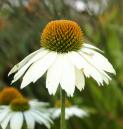BY JOHN P. FREY, PH.G.
From an Inaugural Essay.
After a detailed botanical description of the plant, and a histological description of the bark, accompanied by micro-photographs of the transverse and longitudinal section, the author states the result of his analysis thus: volatile oil 1.28, resin 8.2, mannit 6 to 8, ash 8.9 per cent., starch in considerable quantity, bitter principle, albumen and cellulose.
Ten pounds of well-selected bark was carefully distilled, and from the distillate 896 grains (1.28 per cent.) of volatile oil was collected, only a minute quantity being wasted. The oil was in two portions, one heavier and the other lighter than water; the former was .70 per cent. and the latter .58 per cent. Both oils have a very strong, fragrant, somewhat camphoraceous odor, and a pungent, aromatic taste, the heavy oil being stronger in taste and odor. The odor of the bark is due to these volatile oils. The specific gravity of the heavy oil is 1.012; it is reddish-brown, begins to boil at 200°F., and the temperature gradually rises to 420°F., when it remains constant. It congeals at 38°F. The light oil has the specific gravity .988, is of a light straw color, begins to boil at 185°F.; congealing point about 22°F. Both oils have a strong acid reaction, citric acid acts upon them violently, producing a red resinous mass which is insoluble in alcohol, ether and potassium hydrate. Sulphuric acid produces a deep blood-red color. Iodine dissolves in both oils slowly and quietly. Ferric chloride produces a deep blue color, showing the presence of eugenic acid or eugenol. By neutralizing the oils with potassium hydrate and distilling, the residue is a crystalline mass of potassium eugenate, from which, with sulphuric acid and distilling, eugenol is obtained as a colorless oily liquid, having a pleasant odor. The distillate of the oils with excess of potassium hydrate contained two colorless oils, one heavier and the other lighter than water. The latter is neutral to litmus, and when treated with sulphuric acid turns to blood-red, but nitric acid and ferric chloride do not affect it. The heavy oil was in such small quantities that enough could not be obtained to ascertain its nature.
The resin, which was obtained by exhausting the drug with alcohol, evaporating and pouring the concentrated tincture into water, is of a pale yellowish color, destitute of odor and taste, soluble in ether and chloroform, slightly soluble in cold, more so in boiling solution of potassa; insoluble in turpentine or cold and hot water. The solution in potassa is precipitated on the addition of hydrochloric acid, and the alcoholic solution is precipitated by triplumbic acetate, but not by normal acetate. Both chloroform and ether solutions have a distinct acid reaction. When incinerated it yields a pale yellowish ash.
A crystalline principle was obtained by exhausting the bark with hot water, evaporating the solution to a very small bulk, and allowing this to stand in a warm place for a few days, when the whole mass became crystalline; it was then recrystallized from hot alcohol, the solution being filtered warm through animal charcoal; on the slow evaporation of the alcoholic solution rather large crystals will form. It crystallizes from water in colorless rhombic prisms, and from hot alcohol in fine needle-like crystals. They are freely soluble in cold and hot water; sparingly in cold, but readily in boiling alcohol, again crystallizing out upon cooling; insoluble in ether, and when heated on a platinum dish wholly volatilize. This is the crystalline principle which was called by some of the older writers "Canellin," but which Mayer and Von Reiche, in 1843, showed to be mannit. By a series of tests made in comparison with mannit from manna, I have found the two to be identical.
Wax was found in small quantities by treating the residue exhausted with alcohol with chloroform. Starch is present in considerable quantities, as was shown by the iodine test. The presence of gum was shown by a solution of triplumbic acetate and ammonium oxalate. Albumen is present and can be detected with mercuric chloride, or by coagulating with heat. The bitter principle is isolated with much difficulty; it is soluble in water and alcohol, and is not precipitated by triplumbic nor normal acetate. The bark is entirely free from tannin.
Water extracts 22 per cent. and alcohol 10 per cent. of the constituents of the bark. A tincture and fluid extract prepared some time ago remain perfectly clear. The tincture represents 10 per cent. of the drug with a menstruum of alcohol 3 parts, water 1 part. The fluid extract was made with alcohol, and every cubic centimeter represents a gram of the drug. A solid extract was also prepared by exhausting the drug with alcohol 95 parts and glycerin 5 parts. The ash was analyzed with the following results:
| Calcium carbonate | 83.00 | Insoluble in water. | 88.40 |
| Magnesium carbonate | 1.70 | ||
| Aluminum and ferric oxides | 2.60 | ||
| Calcium phosphate | 1.10 | ||
| Potassium chloride | 1.30 | Soluble in water. | 13.10 |
| Sodium carbonate | 4.50 | ||
| Sodium sulphate | 1.30 | ||
| Sodium chloride | 6.00 | ||
| 101.50 | 101.50 |
The American Journal of Pharmacy, Vol. 56, 1884, was edited by John M. Maisch.

